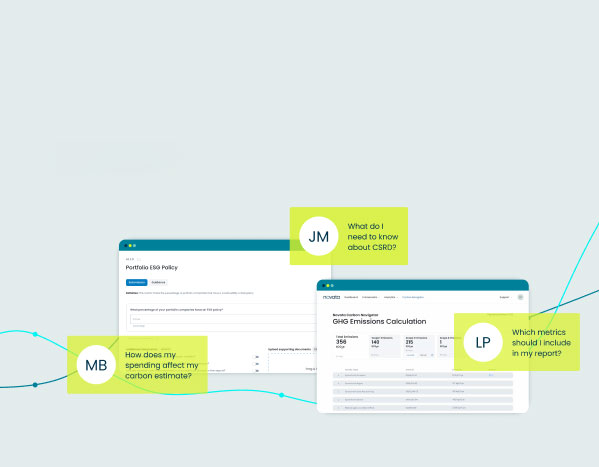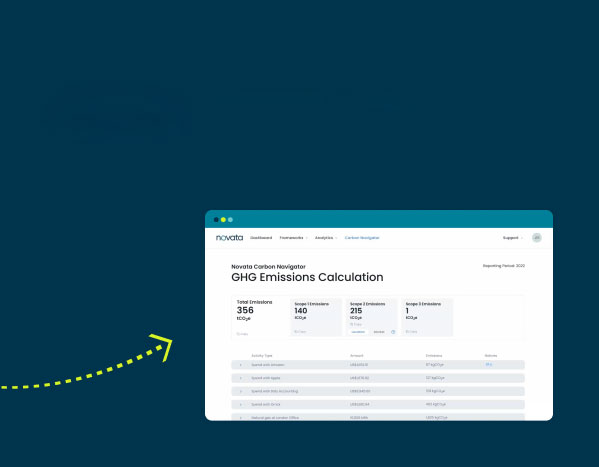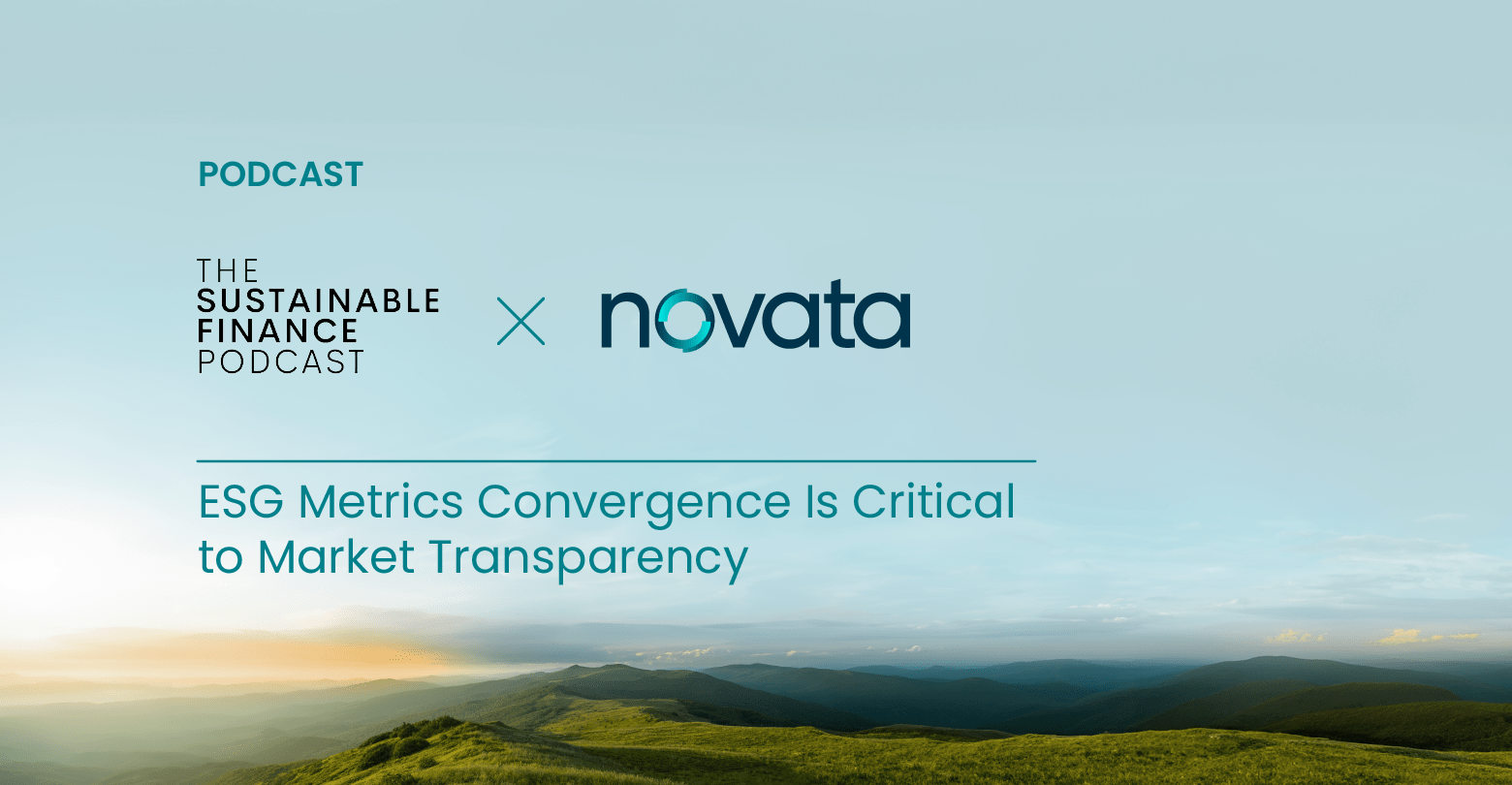In this conversation, Kyle Flick, Director of Services at Novata, dives into the topic of ESG metrics. Kyle’s experience spans a variety of functions in the sustainability and impact investing space, and he works with private equity and venture firms on developing ESG strategies and analyzing data. Listen as he debunks myths about ESG metrics and highlights how firms can identify the metrics that materially impact the business’ bottom line.
About Sustainable Intelligence
Sustainable Intelligence is an interview series from Novata that explores ESG and sustainability in the private markets. From carbon accounting to using data to create value, the series dives into the challenges and opportunities facing private market investors and company leaders as their integrate ESG across the business and respond to regulatory requirements. Each episode centers authentic dialogue, highlighting experts at the forefront of advancing ESG data collection and driving meaningful progress in the sustainability landscape. Listen to more episodes.
Conversation with Kyle Flick (Transcript)
Mateo Leone: Welcome to Sustainable Intelligence, where we discuss all things ESG and sustainability for the private markets, brought to you by Novata.
Today, I’m joined by Kyle Flick, Director of Services at Novata. With experience in a variety of functions across the sustainability and impact investing space, Kyle now helps private equity and venture firms set their ESG strategies and analyze their data. Thank you for joining us today, Kyle.
Kyle Flick: Thanks Mateo. Excited for the conversation.
Mateo: Today, we’re going to be discussing ESG metrics, common misconceptions, the disconnect across the industry, and the metrics that matter. Let’s start by setting the tone for the conversation: what is the biggest myth about ESG metrics that you’d like to debunk?
Kyle: I feel like there are a lot of myths, I think, depending on who you talk to, maybe folks will have a different answer. I think from my perspective, when folks hear ESG typically they either, one, think it’s more about impact investing or measuring your company’s impact on the world. Or when they hear ESG, they typically think of carbon emissions or climate change. I think in both instances, what is probably missed is that for ESG, carbon is just one pillar of ESG. When you think about DEI and HR and a board of directors, things like that, all companies are practicing ESG. This is really just the quantification of those operations. And so, when you think more broadly, then you have this other group that thinks it’s basically less about the operations of a company and more about the impact that a company has on the world.
And so I think I heard at a conference one time, which is a really good line, ESG is how companies act and impact is what they give to the world. And so if you’re confused about what that is, every company can be measured on ESG and so I think folks that are quote unquote against ESG or don’t believe in it, whatever that means, I think would be surprised to know that they’re already practicing it. It’s just really quantifying what it is that they’re doing.
Mateo: Got it so not only is impact investing and ESG not the same thing, which is a good myth too to debunk, but you’re saying that people have been tracking ESG metrics and have been doing ESG without even realizing they’re doing it.
Kyle: 100%. And I think that’s the message I want to get out is even before they called it ESG, you can look back in history over the past hundred years, folks cared about certain things when they invest in businesses. They wanted to know that 75% of their workforce wasn’t leaving the month before. Right. That’s like a very obvious metric as an investor you probably care about, and don’t want to invest in a company or if they have a super high attrition rate.
Way back in the day, people wanted to protect their trade routes. They wanted safety and security of their ships that they were shipping across the world, small things like that. Now we look, the analogous metric in that instance would be cybersecurity or protecting your IP. I mean, these are things that have been happening since the beginning of time. And so we’re just calling it something different to help standardize it because we have new technologies that can help aggregate and standardize those metrics.
Mateo: Got it. So we’ll get to some of the more common, or maybe, the more traditional ESG metrics that businesses have been tracking but where do you think the disconnect in this space comes from?
Obviously at Novata, we’re talking to a lot of different GPs and some are very all in on tracking ESG metrics and others ranges from, don’t really care, a little ambiguous, or not interested at all. So where does that disconnect come from?
Kyle: Yeah, I think, those that maybe were early adopters and practicing ESG or tracking these things saw real value from tracking metrics that materially affected their businesses. And when I say materially affected, namely, I’m talking about metrics that affect their bottom line. They find real value, depending on the industries in which they invest, in tracking specific nonfinancial metrics that actually impact the financial health of the business.
When I’ve worked with different clients, the ones that are bought in either have worked on deals or worked with portfolio companies where they’ve seen real value come from tracking and improving upon these metrics or they’ve talked to other folks in the industry who have had that experience. And I think with ongoing regulation around the world, whether it’s in the EU, we have regulation both in climate and human capital and the US, that regulatory hurdle and cost is just going to be the cost of doing business. And so that’s a real risk you can easily mitigate by starting early. I think there’s a, it’s probably a two-pronged answer. It’s they’ve seen real value being driven by tracking these things and improving on them. And then they know regulation is coming. And whether you agree or disagree, it’s the cost of doing business now.
Mateo: That’s a very fair point, and the regulations are coming. So I’d like to ask about some of those ESG metrics that might be used to assess the financial strength of the business. What metrics are they?
Kyle: The way I’ve thought about it is basically in three buckets. One is metrics that drive top-line growth and revenue for our business. Two, metrics that reduce costs. If you have good performance on these metrics you’re going to reduce your SG&A costs on your income statement. And then the third bucket is minimizing the legal and regulatory risks, which I mentioned earlier, but it’s probably a spinoff of the cost reduction piece as well.
So when I think of top-line revenue, I think of obviously opening up new markets and new product or service innovations. If you’re perceived to be a sustainable company, in consumer goods, for instance, if you have recycled products or you have shirts made out of plastic bottles for instance, and you’re perceived by the market as being sustainable, you could open up a section of the market that you maybe didn’t have access to before.
For cost reduction you think of typical things like, if you reduce energy, reduce water, or you reduce hazardous waste, decrease your carbon footprint. Those types of things. I think of businesses like cruise ships. I think that’s an interesting example. Their net income is wholly dependent on the cost of fuel. Like it’s 15 to 20% of all of their costs. They actually save very directly. That 10% or whatever on their income statement. So, energy intensive businesses, I think, benefit greatly from measuring those types of things. And then I think we touched on the legal and regulatory risks. Different regulations track different things, but typically you’re going to see carbon emissions, water waste, board diversity, board oversight, data security, and data security is a big piece in this digital world that everyone has to track because a data breach can cost upwards of $2 million. And so these are very well-researched metrics and you can actually quantify quite easily.
Mateo: Within the space there’s, there seems to be a lot of confusion around ESG and how it can provide value. Is it difficult because it depends, the metrics, depend on the industry that you’re in? You give the example of the cruise ship or energy intensive organizations, what about a tech company? What about a company with low overhead that maybe doesn’t have that same type of footprint. Where would they see the value?
Kyle: Yeah, really good question. And this is a lot of the work that we do with both investors and companies is looking to find those material metrics. We think there are core metrics that every business can benefit from by tracking but there are organizations like SASB that have done a lot of really good work on a per industry basis on what metrics are most financially material. And so typically, depending on the industry, we’ll be able to go in and see what is most important.
For something like a tech company, things that usually come up would be energy management. A lot of scope three emissions in tech companies, flying to clients and long haul flights, that sort of thing; cybersecurity, data privacy, and then board diversity. I think tech has historically suffered from a lack of diversity and so that’s been a very material metric. But then, as you go to each specific industry, that’s why the work we do is really important. It’s because we think probably 80% of the metrics are going to be pretty core but that last 20% can, you can really toggle to be industry specific and make sure that you’re getting the most value based on what industry the company’s in.
Mateo: So you touched on the diversity metric. Earlier we were talking about the metrics that are most common and how they provide value for firms, by increasing revenue, reducing costs, minimizing risk. From a diversity standpoint, where is that financially material to a business?
Kyle: I think there’s a couple pieces to this one. One, there has been significant research done about the success or stock prices in the public markets of companies with higher levels of diversity and that’s a financial piece. The piece where you mentioned having a more sustainable form of a business. Diversity increasingly matters for younger employees as well. So you look at millennials, gen Z. If you’re thinking about attrition, long term, you better be thinking about your management and board diversity as well, because if employees don’t feel like the decision being made at the top are reflective of them and who they are and what they stand for, you might have an attrition issue down the line.
Mateo: That’s a great point. It also is a great tie into my next question around peripheral metrics or leading indicators that maybe you would look out at a first glance and be like, okay, those aren’t going to really impact my bottom line necessarily, but they could be indicators for future growth or future risk. How do those metrics play into an ESG strategy and what metrics would companies want to look at?
Kyle: We actually just did this exercise for someone for a client, but when we think about leading indicators, we can think about basically questions across their maturity scale. So if you’re really early in your ESG journey, you could ask: how many cyber security incidents did each of your companies have? You get your answers back and then maybe the next year you can say, or even within that same survey, how many of those that had incidents had a policy, had training, are SOC 2 compliant. You can then ask all of these questions underneath that to really uncover where the gap may be. And maybe it’s not so obvious in those questions, but I think that’s probably one example of a leading indicator. Similarly you can look at GHG emissions. Do you track greenhouse gas emissions? If you don’t you’re probably not going to be super aware of your impact, or if typically, if you’re in manufacturing or an asset heavy industry, you will, or at least have some level of awareness, but then you can ask deeper level questions around short-term reduction targets, long-term reduction targets. Things like that can go underneath the initial question. Or going back to attrition, right? What’s your attrition number? Okay. Do you give an employee survey? How many people respond to that survey? What’s the total cost of your employee base? Has that increased year on year?
You can really just dig into that to see why are people leaving? Well, you haven’t given a raise in line with inflation or whatever it is. You can very clearly see that.
Mateo: Great. That’s great feedback.
Kyle: The one note I had here that I just want to be mindful of if people are listening, not everything is about tying it back to the bottom line. And so I think in the conversations we’ve had with folks as clear as some of this research has been around some of these core metrics and themes, there is still a lot of work to be done with that research. It’s really hard to tie back and to prove. At this point that’s work we’re doing, and we don’t write, we’re not over promising that. I think we’re super conscious of impact washing and greenwashing and all of that sort of stuff.
And so while this is very forward-looking in a lot of ways, we’re very conscious that it’s not perfect yet but that’s why more data and more companies tracking these things is actually critical because that’s how we figure it out.
Mateo: Almost as important as a leading indicator within the ESG policy.
Kyle: Bingo.
Mateo: Well, thank you, Kyle, for joining me and sharing your insights on this episode of Sustainable Intelligence. For more insights on ESG and sustainability in the private markets, check out novata.com and until next time, let’s keep building sustainable intelligence together.






